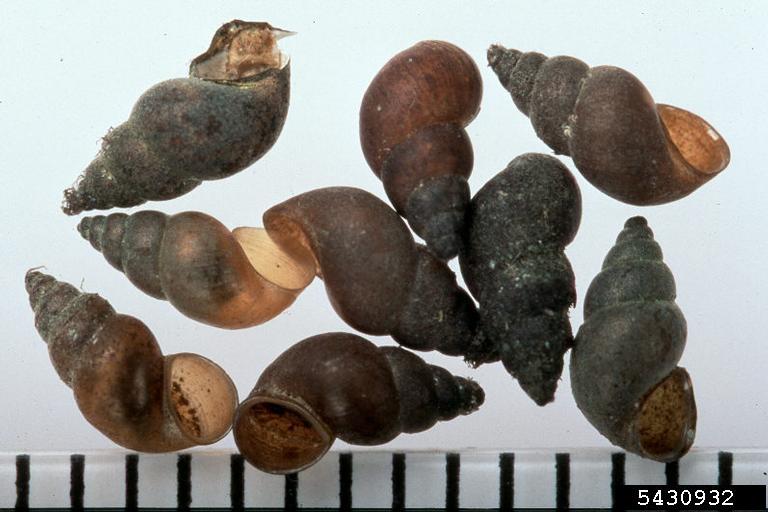FOUND IN B.C.? Yes. They have been reported in Port Alberni, Vancouver Island.
The New Zealand mud snail (Potamopyrgus antipodarum) is native to New Zealand and was first introduced to North America in 1987. It is suspected that they arrived in the ballast water of ships or in imported fish stocks. In Canada, they are found in the Great Lakes, other regions of Ontario and British Columbia. They are found across the Pacific Northwest, and in B.C., they have been reported in Port Alberni—this isolated population on Vancouver Island demonstrates the potential for the species to spread by recreational watercraft and angling equipment. Interestingly, the New Zealand mud snail has been reported to be the most widespread invasive mollusc in the world!
They are extremely small freshwater snails, only about 5 mm long. Their shells are light to dark brown in colour and have 7-8 whorls.

In North America, all individuals are clonal, parthenogenic females. This means that they are genetically identical and that the introduction of a single self-reproducing female is capable of starting a new infestation. They have been documented to reach extremely high densities, as high as 300,000 individuals per m2 in the Madison River and 800,000 individuals per m2 in Lake Zurich.
Contrary to what their name might suggest, New Zealand mud snails can be found in a variety of habitats, including muddy or rocky bottoms and among aquatic plants. Similar to many other invasive invertebrates, the mud snails can tolerate a range of environmental conditions. Although they are generally described as a freshwater species, they are increasingly being found in brackish, estuarine habitats. They are also very hardy: they are capable of surviving out of water for weeks at a time and can survive through the digestive tract of fish. In both their native and invasion ranges, New Zealand mud snails are preyed upon by a variety of fishes, including perch, trout, salmon and mountain whitefish.
Many invasive invertebrates share similar negative impacts on their invaded ecosystems. New Zealand mud snails alter nutrient cycling in freshwater ecosystems, which in turn impacts the productivity (i.e. photosynthesis by microscopic algae) and structure of food webs. Due to their high densities, the invasive snails also outcompete native invertebrates with similar grazing behaviours.
What Can We Do?

CLEAN DRAIN DRY: Clean off all plant parts, animals and mud from watercraft and equipment (e.g. boat trailers, paddles, fishing gear, waders and boots). Drain onto land all compartments and accessories that can hold water (e.g. bilge, ballast, live wells, buckets) and remove plugs before traveling. Dry the watercraft and equipment before launching into another body of water.
DON’T LET IT LOOSE: Never release aquarium pets or plants into the wild. Never discard unused bait into the wild. Be aware of bait restrictions in B.C.
REPORT: Report all sightings of invasive species to CSISS on our website, to the Province with their online form or on the ReportInvasive mobile app.
Literature and Resources
Davidson, T., Brenneis, V., de Rivera, C., Draheim, R., & Gillespie, G. (2008). Northern range expansion and coastal occurrences of the New Zealand mud snail (Potamopyrgus antipodarum Gray, 1843) in the northeast Pacific. Aquatic Invasions, 3(3), 349–353. https://doi.org/10.3391/ai.2008.3.3.12
Kerans, B. L., Dybdahl, M. F., Gangloff, M. M., & Jannot, J. E. (2005). Potamopyrgus antipodarum: Distribution, density, and effects on native macroinvertebrate assemblages in the Greater Yellowstone ecosystem. Journal of the North American Benthological Society, 24(1), 123–138. https://doi.org/2.0.CO;2″>https://doi.org/10.1899/0887-3593(2005)024<0123:PADDAE>2.0.CO;2
Levri, E., Colledge, E., Bilka, R., & Smith, B. (2012). The distribution of the invasive New Zealand mud snail (Potamopyrgus antipodarum) in streams in the Lake Ontario and Lake Erie watersheds. BioInvasions Records, 1(3), 215–219. https://doi.org/10.3391/bir.2012.1.3.07
Therriault, T. W., Weise, A. M., Gillespie, G. E., & Morris, T. J. (2008). Risk assessment for New Zealand mud snail (Potamopyrgus antipodarum) in Canada. Research Document 2010/108. Canadian Science Advisory Secretariat, Fisheries & Oceans Canada.